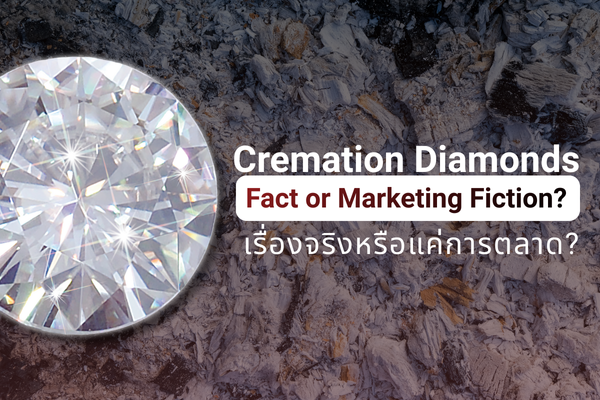

.png)
As a global hub for the gem and jewelry trade, Thailand is committed to fostering a marketplace built on transparency, quality, and trust. For consumers and investors engaging in the purchase of high-value assets like diamonds, a clear understanding of both local regulations and international standards is paramount.
The Thai Gem and Jewelry Traders Association (TGJTA), as the nation's leading industry body, presents this definitive guide to empower buyers. By understanding your rights under the Office of the Consumer Protection Board (OCPB) and applying globally recognized quality metrics, you can ensure your diamond acquisition is both confident and secure.
In Thailand, the trade of gems and jewelry is regulated by the Office of the Consumer Protection Board (OCPB), an agency dedicated to ensuring fair trade and safeguarding consumer rights. The primary legal framework is the Consumer Protection Act, B.E. 2522 (1979), which grants consumers specific rights when purchasing diamonds:
The Right to Receive Accurate and Sufficient Information: Vendors are legally obligated to provide complete and truthful information regarding the diamond's characteristics, including its quality, weight, and any treatments or enhancements it has undergone.
The Right to Free Choice: Consumers must be able to make a purchasing decision free from coercion or misleading sales tactics.
The Right to a Fair Contract: All terms, conditions, and warranties associated with the sale must be clearly stated and must not place the consumer at a disadvantage.
The Right to Redress and Compensation: If a product fails to meet the agreed-upon specifications or if the consumer incurs damages, they have the right to file a formal complaint to seek resolution and fair compensation.
Should a consumer encounter a business that fails to comply with these regulations—for instance, by providing false information or selling a product of a lower quality than advertised—they are encouraged to gather all relevant evidence and file a complaint with the OCPB hotline at 1166 or through its online channels.
To enforce transparency, the OCPB issued the Announcement of the Committee on Labels, No. 7 (B.E. 2544), which mandates that faceted gemstones and jewelry containing them are goods that require controlled labeling. This regulation ensures that consumers have access to critical information at the point of sale.
Key details legally required on a product label in Thailand include:
Name and Address of the Manufacturer or Distributor: For traceability and accountability.
Type of Gemstone: Must be clearly stated as "Diamond."
Weight: Must be specified in "Carats."
Quality: Essential characteristics such as Color, Clarity, and Cut must be detailed.
Price: The total price must be clearly displayed in Thai Baht (THB).
Beyond national regulations, the universally accepted framework for assessing diamond quality is the 4Cs, established by the Gemological Institute of America (GIA). Understanding this standard is essential for any serious buyer.
Carat (Weight): A diamond's weight is measured in carats (1 carat = 0.2 grams). While a higher carat weight generally increases a diamond's price, the other quality factors are equally critical in determining its true value.
Color: This grade evaluates the absence of color in a diamond. The GIA scale ranges from D (completely colorless) to Z (light yellow or brown). The more colorless a diamond is, the more valuable it becomes.
Clarity: This refers to the assessment of internal flaws (inclusions) and external blemishes under 10x magnification. The clarity scale ranges from Flawless (FL), indicating no inclusions or blemishes, to Included (I), where imperfections are visible to the naked eye.
Cut: Arguably the most significant factor influencing a diamond's brilliance and sparkle. A well-cut diamond will interact with light to create maximum fire and scintillation. GIA grades cut on a scale from Excellent to Poor.
Recommendation: Always request a Diamond Certificate from an internationally respected gemological laboratory, such as GIA or IGI. This report provides an impartial and detailed analysis of the diamond's 4Cs and serves as irrefutable proof of its identity and quality.
While legal frameworks provide protection, awareness of potential issues is a buyer’s best defense. Common disputes in the diamond trade include:
Quality Misrepresentation (Grade Bumping): A seller inflates a diamond's quality, claiming a higher color or clarity grade than what is stated on its certificate, or sells an uncertified diamond at an exaggerated price.
Product Swapping (The 'Switcheroo'): A lower-quality diamond is substituted for the higher-quality stone the customer originally selected, often during the process of setting it into a piece of jewelry.
Deception Regarding Carat Total Weight (CTW): A seller advertises the total carat weight of all diamonds in a piece, leading the buyer to mistakenly believe it is the weight of the single center stone. A single large diamond is significantly more valuable than multiple smaller diamonds of the same total weight.
Non-Disclosure of Treatments: The seller fails to inform the buyer that a diamond has undergone treatments—such as heating, HPHT (High Pressure/High Temperature), or fracture filling—to enhance its appearance. Such treatments can impact the diamond's value and durability.
Purchase from Reputable Retailers: Prioritize vendors with an established reputation, particularly members of the Thai Gem and Jewelry Traders Association (TGJTA), who are held to high standards of ethics and professionalism.
Always Verify the Certificate: Insist on a certificate from a recognized international laboratory. Cross-reference the report number with the laser inscription on the diamond's girdle to ensure they match.
Conduct Price Comparisons: Research the market to understand the appropriate price range for a diamond with specific 4Cs characteristics.
Secure a Written Agreement: Always obtain a detailed receipt and a warranty that explicitly lists the diamond’s specifications, alongside the store's return or exchange policy.
In Case of a Dispute: If you suspect fraudulent activity, immediately gather all documentation—including receipts, certificates, and photographs—consult with an independent gemologist, and file a report with the OCPB.
Ultimately, a thorough understanding of your rights and a meticulous approach to verifying a diamond’s quality are the most effective safeguards for your investment. This commitment to consumer education and market integrity is a cornerstone of Thailand’s leadership as a trusted, world-class Jewelry Hub.

In an era where people seek unique ways to memorialize their departed loved ones, "Cremation Diamonds" have emerged as a compelling option. Various companies claim they can extract carbon from cremation ashes or hair to synthesize beautiful, genuine diamo

TGJTA in collaboration with HKETO, HKTDC, and InvestHK is pleased to invite members and industry professionals to attend a special seminar and networking dinner.

A "Convergence of Value"—a phenomenon where jewelry and gemstones are no longer mere accessories, but have evolved into one of the world's most robust Alternative Asset Classes.